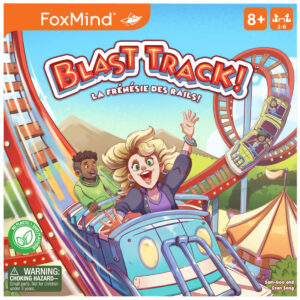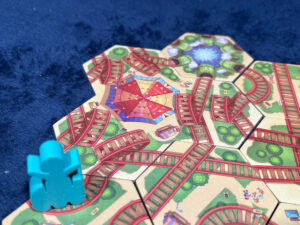 Earlier this year, I tasked the BGQ team with posting their Top 5 games of all time. I wanted to give our readers a bit of insight into what kind of games each of our team members loves. For example, if you created a Venn diagram of me and fellow reviewer Dylans’ Top 5, there would not be any overlap unless you count “is played on a tabletop” as a comparison. I bring this up because if you scroll down to my partner in crime Heather’s #1 game, it’s Slide Blast from FoxMind Games. Why does she love Slide Blast so much? Feel free to ask her at a convention sometime.
Earlier this year, I tasked the BGQ team with posting their Top 5 games of all time. I wanted to give our readers a bit of insight into what kind of games each of our team members loves. For example, if you created a Venn diagram of me and fellow reviewer Dylans’ Top 5, there would not be any overlap unless you count “is played on a tabletop” as a comparison. I bring this up because if you scroll down to my partner in crime Heather’s #1 game, it’s Slide Blast from FoxMind Games. Why does she love Slide Blast so much? Feel free to ask her at a convention sometime.
But this is relevant because this summer, publisher FoxMind Games released an updated version of their 2016 title called Blast Track. Taking the theme from a water park to a roller coaster, and adding in a bit more depth, designers Sam-goo and Evan Song hope to intrigue gamers with this newest offering. Did they succeed? Let’s find out!
Gameplay Overview:
I’ll forgive you if you aren’t super familiar with the almost decade-old game Slide Blast. But this new version builds upon a lot of the same mechanics as the original but adds in a few new wrinkles.
On a player’s turn in Blast Track, they first draw a tile from the market (3 face-up choices) and add it to their hand of 1 tile. They then choose one of those two tiles to add to the end of their roller coaster track. They slide their car meeple to the end of the track and adjust their score marker if needed. What score markers you say?

Each player now has a score track with 5 different categories on it: Tunnels, Speed, Loops, Helping, and Connections. Every time a player’s token goes over a Tunnel, Speed track, or Loop, they increase their score on that track by 1. When they move another player’s meeple by playing a tile that also connects to their track, they increase their Helping score by one. Finally, when they place a tile that allows them to roll over at least 2 other previously placed tiles, they increase their Connection score by one.
What’s interesting now is that if any of those scores (other than connection) increase past 5, they start going down instead as your roller coaster gets too scary for the riders.
After the last tile is played, players total up their score from each of the 5 categories on their score track, along with the total length of their roller coaster. Highest score wins.

Game Experience:
Despite being from 2016 and also being a very light game, Slide Blast remains on my shelf to this day and has gotten plenty of table time. So I was pretty eager to get my hands on Blast Track once I heard about it. I’ve long nagged publisher FoxMind for an expansion to Slide Blast, as my biggest gripe was always the lack of variety in the tiles. I will say that I’m slightly bummed to see the theme change from water slides to roller coasters as water slides are a really unused theme. I have lots of roller coaster type games, but only one water slide. Alas.

So how does Blast Track compare? It’s definitely a somewhat deeper experience than Slide Blast as you now have 5 categories to manage whenever your rider moves. Loops, tunnels, helping, and speed hills are all pretty straightforward, and I actually really liked the idea of decreasing values as you get too much in any category. It’s on theme that if your roller coaster is too fast or too nauseating your riders start losing enjoyment. That’s straight out of my 100+ hours spent playing the Planet Coaster video game where coaster statistics affect rider enjoyment.
I will say that we were tripped up a little bit with the connection score. The rulebook was a tad confusing on when exactly you earn it. Is it when you put a tile down and go over 1 extra? 2 extra? 3 extra? In the first game we just skipped using it because my kids weren’t getting it. Eventually, we wrapped our head around how it works and now use it in every game.

But my real benchmark for this review is what Heather thinks of it. Slide Blast is her all-time favorite game, so does Blast Track knock it out of the pole position. Unfortunately, it doesn’t. She says she still prefers Slide Blast. And I get it. In an era where “cozy games” are starting to pick up a lot of steam (see Dorf Romantik), there is something fantastic about the zen-like gameplay of Slide Blast where you play a tile, move your rider and the next person goes. For her, having to manage the 5 sliders on the score track took away from the elegant simplicity of Slide Blast.
While I can appreciate her desire for a streamlined experience, myself, I prefer this new version (theme aside). With the 5 scoring categories, it can require you to think a little harder about what tile you take. Are you teetering really close to the 5 limit on speed tiles? Then maybe I don’t want to grab one of those, but a boarding straightaway instead. This extra layer of decision-making helps make for more meaningful choices and a slightly meatier experience.
But the good news is that you can actually play Blast Track using the Slide Blast rules (which we tried). Just simply leave out the scoring tracks and enjoy the increased variety of tiles. If you playing with younger kids, this might be a good option to use.
Final Thoughts:
While it may not be displacing the 8-year-old Slide Blast as Heather’s favorite game, Blast Track is still a good game in its own right. It takes the core of Slide Blast and adds in a decent amount of depth, but keeps it almost as accessible. However, the trade-off is that you lose a bit of the casual simplicity that made Slide Blast such a hidden gem. For those looking for a light tile-laying game, Blast Track is still a lot of fun and if you grab a copy of the Slide Blast rulebook, you can even get a “even lighter still” game mode for this great family game.





















